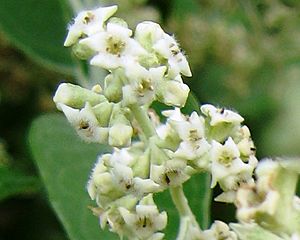Buddleja cordata facts for kids
Quick facts for kids Buddleja cordata |
|
|---|---|
 |
|
| Buddleja cordata flowers | |
| Scientific classification | |
| Genus: |
Buddleja
|
| Species: |
cordata
|
| Synonyms | |
|
|
Buddleja cordata is a special plant that grows naturally only in Mexico. It likes to grow near the edges of forests and along rivers. You can find it in places that are quite high up, between 1500 and 3000 meters (about 4,900 to 9,800 feet) above sea level. This plant has also started growing wild in some parts of Ethiopia, even though it's not originally from there. A scientist named Kunth was the first to describe and name this plant in 1818.
Contents
What Does Buddleja cordata Look Like?
Buddleja cordata is a large deciduous shrub or tree. "Deciduous" means it loses its leaves every year, usually in autumn. It can grow up to 20 meters (about 65 feet) tall in the wild. The trunk can be as wide as 45 centimeters (about 18 inches). It has bark that is brownish or blackish and has deep grooves.
The leaves of this plant are shaped like an egg or are long and narrow. They grow in pairs, opposite each other on the stem. Each leaf is about 4 to 23 centimeters (1.5 to 9 inches) long and 3 to 14 centimeters (1 to 5.5 inches) wide. They have small stems called petioles that are 1 to 4 centimeters long.
The flowers grow in clusters at the end of the branches. These clusters are called inflorescences and look like long, branched sprays, 6 to 30 centimeters (2.5 to 12 inches) long. The small, sweet-smelling flowers are grouped together in smaller bunches called cymules. The flower petals, known as the corolla, are white, cream, or yellow. They often have a touch of orange color in the center. Each flower is about 1.5 to 2.5 centimeters (0.6 to 1 inch) long.
Where Does Buddleja cordata Grow?
This plant is known to be quite tough and can handle cold weather, even in places like the UK. You can find a very large Buddleja cordata plant in the Centenary Border at the Sir Harold Hillier Gardens in Hampshire, England. Another one is part of a special plant collection at Longstock Park Nursery, also in Hampshire.
This plant can grow well in areas that are in USDA zone 8. This zone tells us how cold a plant can get before it gets damaged.
How Is Buddleja cordata Used?
Buddleja cordata and other plants in its family contain special natural chemicals. These chemicals are called metabolites, like flavonoids and iridoid glycosides. Scientists are studying these chemicals because they show promise in helping to treat various health problems.
See also
 In Spanish: Tepozán para niños
In Spanish: Tepozán para niños




